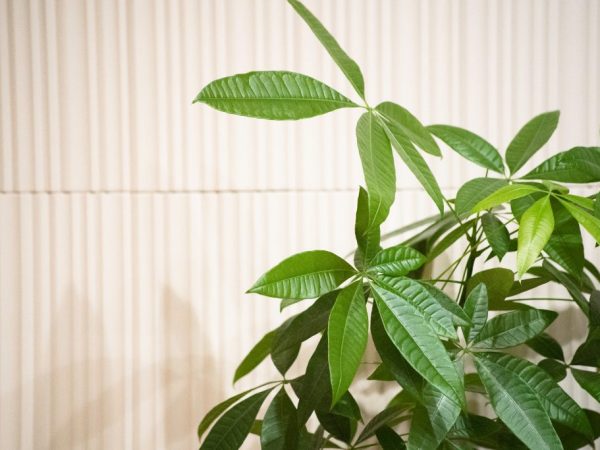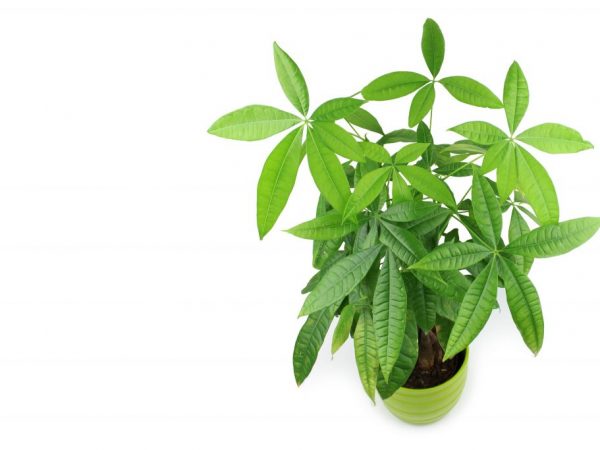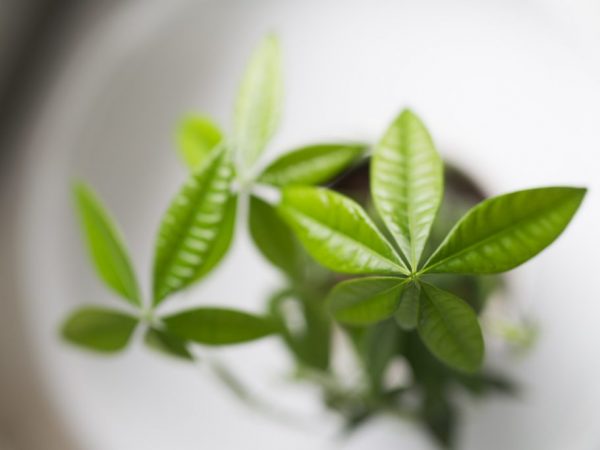Pakhira - conditions for home cultivation
Pakhira is a tree from the subfamily of flowering plants Bombax. Refers to the Malvovs. Originally from South and Central America. Found in India and Africa. The genus includes more than 45 species; aquatic pakhira is most suitable for growing at home.

Pakhira - conditions for home cultivation
Botanical characteristic
Pakhira looks like a palm tree, in the wild the tree grows up to 20 m, at home - only up to 3 m. There are related cultures - baobab and durian.
Description:
- the barrel has a thickening at the bottom for the accumulation of nutrients and water, similar in appearance to a bottle,
- the leaves are bright green, the surface is glossy, shiny, the structure is leathery, attached on long petioles, with a finger-like complex shape similar to chestnut;
- the flowers are medium, collected in a paniculate inflorescence about 15-35 cm long, the flowering is white with a yellowish tinge, the stamens are bright pink, the smell is vanilla;
- fruits are green, oval shape, length up to 25 cm, can hold up to 25 pcs. nuts, seeds are edible raw and fried, are used in the bread industry for the production of flour and bakery products.
There is no flowering in the artificial environment.
According to signs and superstitions, pakhira brings happiness to the house.
Varieties
In domestic cultivation, several varieties are best known.
- Water. Also called aquatica, water, water chestnut. The classic representative of pakhira. Height about 3 m, crown diameter up to 1.5 m. Growth growth is slow.
- Silver. Similar to aquatic, but differs from it in a silver striped pattern on the leaves.
- Round-leaved. It is rare at home. The ampel variety is more often used in decorating office premises. Differs in long leafy shoots and a round shape of leaf plates.
Purchase and adaptation
The best time to buy is spring. When choosing a plant, you should pay attention to its appearance. A healthy flower:
- rich green foliage;
- no damage to the trunk and roots;
- there are no spots on the sheet plates.
The average price is 700 rubles.
After the acquisition, the pakhira is quarantined for 2 weeks, and then transplanted:
- get out of the pot, shake off the excess remnants of the earth;
- the roots are immersed in water for 15 minutes to wash off the soil;
- the root system is examined for the presence of rotten areas, the damaged fragments are cut off;
- the pot is chosen 2-5 cm in diameter more than the area of the underground part;
- the bottom is covered with drainage, from above - with earth to the level of 2/3 of the height of the pot container, forming a cone in the central part;
- pakhira is placed on the hillock, the roots are straightened, the soil is poured, filling the voids.
Planting and transplanting
A shallow and wide pot is suitable for a houseplant.In too large a container, the risk of moisture stagnation and souring of the earth increases, which causes the appearance of fungal diseases.
The frequency of transplanting depends on the age of the flower culture:
- a young plant requires an annual pot change;
- adult pakhira (from 5 years old) grows without transplant for 3-4 seasons;
- for an old flower, they manage by changing the surface layer of the soil to a depth of about 5 cm.
The bottle tree is transplanted in the spring, around March-April. The best way is transshipment without replacing the substrate in order to avoid trauma to the roots.
Immediately after transplanting, to adapt to new conditions, the flower pot is placed for 2-3 days in a shaded place, the plants are not fed for 2 weeks from the moment of planting in fresh soil.
The necessary conditions

Protect the flower from drafts
The most suitable place is the east or west window, where direct sunlight is observed only in the morning and evening hours. In summer, when facing south, the plant needs shading from 12 to 17 hours. When placed in the northern part, it requires additional lighting.
In the summer season, it is shown outdoors. Susceptible to drafts and overheating from heating appliances.
Under natural conditions, it grows on marginal lands. Mandatory requirements for the substrate are high air permeability and good drainage.
The recommended acidity level is neutral or low, but the plant can also grow in acidic and alkaline soils.
For planting, ready-made soil is suitable for growing decorative indoor deciduous and palm crops. Perlite or vermiculite is additionally added to it in an amount of about ¼ of the total volume of the mixture, which helps to increase the aeration of the soil layers.
You can make a soil mixture yourself by mixing in equal parts sod and leafy soil, coarse sand and brick chips.
Humidity
The culture is undemanding to humidity conditions, easily tolerates being surrounded by dry air, but responds well to spraying on foliage, which is why the aboveground part increases brightness. Frequency - up to 2 times a day, avoiding hitting the barrel.
Recommended rates are about 50-60%.
Temperature
The heat-loving tropical flower requires high temperatures. Optimal mode:
- in spring and summer - 22-25 ° С, an excess of 35 ° С leads to the termination of plant growth;
- in autumn and winter - 14-16 ° С, the minimum allowable limit is 6-7 ° С, at which foliage begins to fall, at 0 ° С the culture dies.
Lighting
Needs good lighting. With a lack of light, it loses its decorative effect: the leaves become pale, the stem stretches.
The optimal daylight hours are 10 or more hours. The lack of lighting in winter is compensated by the use of artificial light sources.
Regular 45 ° rotation of the flowerpot ensures even crown development.
Care
Watering
The water should be separated, without chlorine, 2-3 times higher than room temperature. Water the flower under the root, avoiding moisture on the trunk, or by immersion for 0.5-1.0 hours.
The immersion method is not used if the ambient air is less than 20 ° C or if the pakhira was recently transplanted.
The frequency of moistening depends on the rate of soil drying and is usually about 2-3 times a month in summer and up to times in a similar interval in winter.
The plant is able to withstand a short-term drought, consuming water accumulated in a thick trunk, therefore the main rule that should be followed when organizing irrigation procedures is to underfill rather than overfill.
Top dressing
Pakhira is fed from the beginning of spring to the onset of autumn, when active growth is observed. For the winter, feeding is canceled.
Ready-made universal fertilizers intended for indoor plants are suitable for nutrition (the dosage is halved).
Often, root dressing is combined with watering: half of the volume is watered) the plant, the second part is mixed with the nutrient composition.
Trimming and shaping

The plant can be shaped in different ways.
For decorative purposes, the flower culture is cut in the spring. When pruning, strongly elongated shoots that stand out from the total mass are subject to shortening, which are subsequently taken for reproduction. The shoots that have appeared on the stem are also removed.
Due to its slow growth, pachira can be used to create a bonsai tree.
When planting several plants at once in a single pot, a trunk is formed in the form of a braid with a heel. For such a procedure, only young specimens with still non-lignified, flexible stems are suitable. It is better to braid the trunks not once, but in several approaches, fixing at intermediate stages with a rope.
Reproduction methods
At home, pakhira propagates by cuttings and seeds.
Seminal
Only high-quality seeds are suitable for sowing, preferably not so long ago extracted from the fruits after flowering. Due to their large size, they are planted immediately in separate containers - small pots or plastic cups.
A peat mixture of peat and sand (perlite) is prepared for planting in a ratio of 5: 3. The seeds are buried 1-2 cm, directing the light spot (eye) to the side. The sowing is watered and covered with plastic wrap or glass cover to create a greenhouse.
For successful germination of seedlings, the temperature is maintained at about 25 ° C-27 ° C.
As the shoots appear, the shelter is removed, organizing the airing and moistening of the soil from the spray bottle. The hardened sprouts can be rearranged to a permanent place, when they have 3-5 sheets each, providing them with care as for an adult plant.
Cuttings
- From the upper part of the lignified shoots, shoots up to 15 cm long with well-developed 3-5 leaves are chosen.
- They are rooted in peat and coarse sand mixed in equal proportions.
For fast rooting, you need to create greenhouse conditions and maintain high humidity, and stimulants are also used.
It takes 4-6 weeks to root the cuttings, after which it is necessary to care for it like an adult flower.
Treatment of diseases and pests
Dry air is undesirable for pakhira. under such conditions, the risk of a spider mite appearing on it increases. Other pests include mealybugs and scale insects.
Individual changes in appearance, illness and loss of decorativeness of an indoor flower are often caused by a violation of care.
| Type of defeat | Control measures |
| Spider mite. Signs - the appearance of white dots (puncture sites) and cobwebs on the foliage. | Increase the humidity in the room. The plant is given a warm shower and treated with insecticidal preparations, for example, Aktellik and Aktara. |
| Mealybug. Its appearance will be prompted by whitish cotton raids in the leaf sinuses and on the stems. | Harmful insects are collected by hand by wiping the vegetative mass with soapy water (50 g per 1 water). In case of mass infestation, the flower culture is sprayed with a suitable insecticide, for example, Aktara, Confidor, and the substrate infected with larvae is replaced with a fresh one, having previously disinfected the pot. |
| Shield. Leaves a waxy coating on foliage and shoots. | Control measures are similar to the way to get rid of mealybugs. |
| Leaves turn yellow and fall. Caused by prolonged exposure to dry air and lack of nutrition. | An indoor flower is sprayed over the foliage. In winter, the humidity is increased with air humidifiers or in other suitable ways. Introduce according to the timing of feeding |
| Dry foliage. Appears more often when getting sunburn. | The flower pot is rearranged for the first time in a shaded place, then under diffused light. In the absence of the possibility of permutation, shading is provided. |
| Brown spots on the leaf blades. Tips dry.The first sign of a lack of water. | Watering is normalized with alternating sprays on foliage. |
| Loss of turgor by the leaf mass. It is a consequence of overflow. | Reduce watering. The filled flower is transplanted into a fresh substrate. |
| White bloom with a fleecy structure on foliage. Powdery mildew symptom. | The plant is sprayed with a fungicide, for example, Skor, Topaz, after cutting off the damaged areas. |
| The flower sheds withered and yellowed leaves. Serves as a symptom of the development of a fungal disease - root rot due to stagnant water. | The root system is examined, the rotten fragments are cut off, the survivors are treated with a weak pink solution of potassium permanganate or a fungicide. The substrate is changed to a fresh one, after having disinfected the pot. |

